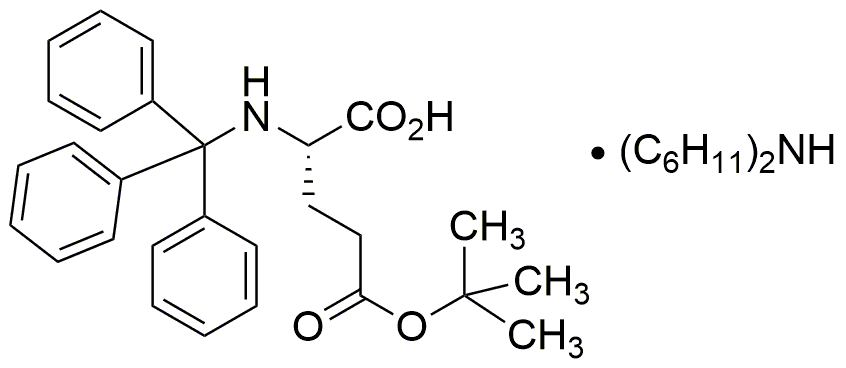Trityl-L-glutamic acid g-tert-butyl ester dicyclohexylammonium salt is widely utilized in research focused on:
- Pharmaceutical Development: This compound serves as a key intermediate in synthesizing various pharmaceuticals, particularly those targeting neurological disorders, enhancing drug efficacy and stability.
- Biochemical Research: It is employed in studies related to amino acid metabolism, providing insights into metabolic pathways and potential therapeutic targets.
- Peptide Synthesis: The compound is valuable in solid-phase peptide synthesis, allowing researchers to create complex peptides with improved yields and purities compared to traditional methods.
- Drug Delivery Systems: Its unique properties make it suitable for developing advanced drug delivery systems, enhancing the bioavailability of poorly soluble drugs.
- Research on Neurotransmitter Receptors: This chemical is used in the investigation of glutamate receptors, contributing to the understanding of synaptic transmission and potential treatments for cognitive disorders.
General Information
Properties
Safety and Regulations
Applications
Trityl-L-glutamic acid g-tert-butyl ester dicyclohexylammonium salt is widely utilized in research focused on:
- Pharmaceutical Development: This compound serves as a key intermediate in synthesizing various pharmaceuticals, particularly those targeting neurological disorders, enhancing drug efficacy and stability.
- Biochemical Research: It is employed in studies related to amino acid metabolism, providing insights into metabolic pathways and potential therapeutic targets.
- Peptide Synthesis: The compound is valuable in solid-phase peptide synthesis, allowing researchers to create complex peptides with improved yields and purities compared to traditional methods.
- Drug Delivery Systems: Its unique properties make it suitable for developing advanced drug delivery systems, enhancing the bioavailability of poorly soluble drugs.
- Research on Neurotransmitter Receptors: This chemical is used in the investigation of glutamate receptors, contributing to the understanding of synaptic transmission and potential treatments for cognitive disorders.
Documents
Safety Data Sheets (SDS)
The SDS provides comprehensive safety information on handling, storage, and disposal of the product.
Product Specification (PS)
The PS provides a comprehensive breakdown of the product’s properties, including chemical composition, physical state, purity, and storage requirements. It also details acceptable quality ranges and the product's intended applications.
Certificates of Analysis (COA)
Search for Certificates of Analysis (COA) by entering the products Lot Number. Lot and Batch Numbers can be found on a product’s label following the words ‘Lot’ or ‘Batch’.
Numéro de catalogue
Numéro de lot/série
Certificates Of Origin (COO)
This COO confirms the country where the product was manufactured, and also details the materials and components used in it and whether it is derived from natural, synthetic, or other specific sources. This certificate may be required for customs, trade, and regulatory compliance.
Numéro de catalogue
Numéro de lot/série
Safety Data Sheets (SDS)
The SDS provides comprehensive safety information on handling, storage, and disposal of the product.
DownloadProduct Specification (PS)
The PS provides a comprehensive breakdown of the product’s properties, including chemical composition, physical state, purity, and storage requirements. It also details acceptable quality ranges and the product's intended applications.
DownloadCertificates of Analysis (COA)
Search for Certificates of Analysis (COA) by entering the products Lot Number. Lot and Batch Numbers can be found on a product’s label following the words ‘Lot’ or ‘Batch’.
Numéro de catalogue
Numéro de lot/série
Certificates Of Origin (COO)
This COO confirms the country where the product was manufactured, and also details the materials and components used in it and whether it is derived from natural, synthetic, or other specific sources. This certificate may be required for customs, trade, and regulatory compliance.

